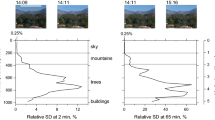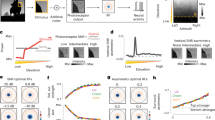Abstract
IT is usual to advance a physical explanation of the scintillation of stars. Thus Wood1 suggests that gradations in the refractive index of the atmosphere give rise to striæ. The gradations are said to be due to hot and cold currents which act as convex and concave cylindrical lenses. Wood also thinks that the disappearance of the effect when a given star is viewed through a telescope is due to the objective collecting several such striæ (which are 3–4 cm. apart), the average illumination being constant. Recently, however, a physiological explanation has been advanced (Hartridge2) ; both change of brightness and colour are ascribed to the slight movement of the star image over the retina and also to local variations in the retinal receptors, which will be more sensitive in some parts and less so in others ; where red receptors abound there will be a bias in favour of red, whereas other regions will be more favourable to green, for example. It seems likely that Holmgren3 was the first to observe variations in hue in a local source of light. He found that a monochromatic yellow light was sometimes seen red, sometimes green, and sometimes colourless. Blue was found to appear green, blue, violet or colourless.
This is a preview of subscription content, access via your institution
Access options
Subscribe to this journal
Receive 51 print issues and online access
$199.00 per year
only $3.90 per issue
Buy this article
- Purchase on Springer Link
- Instant access to full article PDF
Prices may be subject to local taxes which are calculated during checkout
Similar content being viewed by others
References
Wood, “Physical Optics", 3rd ed., p. 91 (New York: The Macmillan Company).
Hartridge, Phil. Trans. Roy. Soc., B, 232, 618 (1947).
Holmgren, Cong. period-internat. and sci. méd. C.R. Copenhagen, 1, 93 (1884).
Tousey and Hulburt, J. Opt. Soc, Amer., 38, 891 (1948).
Pirenne, Proc. Camb. Phil. Soc., 42, 78 (1946)
Author information
Authors and Affiliations
Rights and permissions
About this article
Cite this article
HARTRIDGE, H., WEALE, R. The Scintillation of Stars. Nature 164, 999–1000 (1949). https://doi.org/10.1038/164999a0
Issue Date:
DOI: https://doi.org/10.1038/164999a0
This article is cited by
-
Die Szintillation der Sterne
Die Naturwissenschaften (1960)
-
The Scintillation of Stars
Nature (1950)
-
The Scintillation of Stars
Nature (1950)
-
The Scintillation of Stars
Nature (1950)
-
The Scintillation of Stars
Nature (1950)
Comments
By submitting a comment you agree to abide by our Terms and Community Guidelines. If you find something abusive or that does not comply with our terms or guidelines please flag it as inappropriate.



